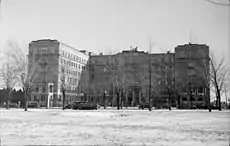Hôpital Notre-Dame
Hôpital Notre-Dame (English: Notre Dame Hospital) is a hospital in Montreal, Quebec, Canada. It is located on Sherbrooke Street East in the borough of Ville-Marie, across from La Fontaine Park. It was established in 1880, and has been at its present site since 1924.
| Hôpital Notre-Dame | |
|---|---|
| Centre hospitalier de l’Université de Montréal | |
 Hôpital Notre-Dame in 1937 | |

| |
| Geography | |
| Location | 1560, rue Sherbrooke Est Montreal, Quebec, Canada H2L 4M1 |
| Coordinates | 45.526°N 73.564°W |
| Organisation | |
| Care system | RAMQ |
| Funding | Public |
| Type | Teaching |
| Affiliated university | Université de Montréal Faculty of Medicine |
| History | |
| Opened | 1880 |
| Links | |
| Website | chumontreal |
History
Around 1880, Université Laval à Montréal decided to found a hospital. The secretary of Université Laval à Montréal, Dr. Emmanuel Persillier-Lachapelle, was given the mandate to establish the new health institution, assisted by the Sulpician Victor Rousselot, parish priest of Notre-Dame, as well as Mother Julie Haineault-Deschamps, of the Congregation of the Grey Nuns. Hôpital Notre-Dame opened on July 27, 1880, housed on the former premises of Donegana's Hotel on Notre-Dame Street.[1]
From the beginning, the hospital was a secular institution. It was administered by physicians rather than priests, which was considered innovative for its time. In the late nineteenth century, Hôpital Notre-Dame became one of the largest hospitals in the country, with six specialized departments: general practitioners, surgery, psychiatry, otolaryngology, ophthalmology and electrotherapy.
In 1898, sister Élodie Mailloux founded the first French Canadian nursing school at the hospital. During its existence, the school trained over 3000 graduates. The first intervention asepsis in Canada was conducted at Hôpital Notre-Dame in 1899. Hôpital Notre-Dame has been associated with Université de Montreal since its establishment in 1920. In 1924 the Hôpital Notre-Dame moved into the space it currently occupies on Sherbrooke Street.[1]
In 1996, the merger of the Hôtel-Dieu de Montréal, the Hôpital Notre-Dame and the Hôpital Saint-Luc followed the creation of the Centre hospitalier de l’Université de Montréal (CHUM). With the completion of the CHUM megahospital in downtown Montreal in 2017, Hôpital Notre-Dame is slated to remain open as a local hospital.
1934 Internes Strike
On 14 June 1934, the internes at Notre-Dame commenced Canada's first medical strike to protest the appointment of a "Hebrew", Dr. Sam Rabinovitch, to the staff. Dr. Rabinovich was the highest ranking graduate of his class from the Université de Montréal, and was offered the position of chief intern. In early June 1934 a petition signed by doctors and interns of Notre-Dame was submitted to the hospitals board, requesting that the contract between the Hospital and Rabinovich be "broken". After a lengthy deliberation by the hospital board it was decided to uphold the contract and hire Rabinovitch[2]
Thirtytwo resident doctors walked off the job rather than work with Rabinovich, and by the 17th of June the strike had expanded to include interns from five other Montreal hospitals, with nurses threatening to join the strike. Quebec Nationalist groups and media such as The Saint-Jean-Baptiste Society and Le Devoir quickly backed the striking internes.[3]
"In view of the distressing, serious and dangerous condition to which the patients of the Nôtre-Dame and other hospitals have been exposed because of the refusal of a number of their internes to take orders from their superiors and the embarrassment that the various boards of Nôtre-Dame and other hospitals, I feel it my duty as a Physician to tender my resignation as interne to your hospital."
— Samuel Rabinovitch excerpt Letter of Resignation.
Rabinovitch formally resigned from his position on 18 June.[4][5] The culmination of this and other antisemitism events led the Jewish community in Quebec to create their own hospital. Funds for the new Jewish General Hospital were obtained through charitable drives headed by Allan Bronfman, Sir Mortimer Davis and J.W. McConnell from the Jewish and Protestant communities.[6]
Pavillon Mailloux

The Pavillon Mailloux is a five-storey brick nurses’ residence on the campus of the Hôpital Notre-Dame. It was constructed as a purpose-built residence in 1931. It was designated as a National Historic Site of Canada on November 23, 1997 its commemoration of the growing professionalism of nursing and the expanding role of women in health care.[7]
References
- "L'Hôpital Notre-Dame". Centre hospitalier de l’Université de Montréal (in French). Archived from the original on 25 December 2011.
- Tulchinsky, Gerald. Canada's Jews: A People's Journey. University of Toronto Press. ISBN 9780802093868.
- Tulchinsky, Gerald. Canada's Jews: A People's Journey. University of Toronto Press. ISBN 9780802093868.
- Wilton, Peter (9 December 2003). "Days of shame, Montreal, 1934". Canadian Medical Association Journal. 169 (12): 1329.
- Woolf, Sarah. "Dr. Sam Rabinovitch and The Notre-Dame Hospital Strike - Hôpital Notre-Dame". Museum of Jewish Montreal. Retrieved 14 November 2018.
- Fong, William (2008). J.W. McConnell: Financier, Philanthropist, Patriot. McGill-Queen's Press. ISBN 0773577807.
- Pavillon Mailloux. Canadian Register of Historic Places. Retrieved August 17, 2011.
External links
| Wikimedia Commons has media related to Hôpital Notre-Dame (Montreal). |
- Histoire (in French)
- Centre Hospitalier de l'Université de Montréal (in French)
- UMF CHUM Notre-Dame (in French)
